
Anthony the Great was a Christian monk from Egypt, revered since his death as a saint. He is distinguished from other saints named Anthony, such as Anthony of Padua, by various epithets: Anthony of Egypt, Anthony the Abbot, Anthony of the Desert, Anthony the Anchorite, Anthony the Hermit, and Anthony of Thebes. For his importance among the Desert Fathers and to all later Christian monasticism, he is also known as the Father of All Monks. His feast day is celebrated on 17 January among the Eastern Orthodox and Catholic churches and on Tobi 22 in the Coptic calendar.

Giovanni di Pietro di Bernardone, OFM, better known as Francis of Assisi, was an Italian mystic and Catholic friar who founded the Franciscans. He was inspired to lead a life of poverty as an itinerant preacher. One of the most venerated figures in Christianity, Francis was canonized by Pope Gregory IX on 16 July 1228. He is usually depicted in a robe with a rope as a belt.

Anthony of Padua, OFM or Anthony of Lisbon was a Portuguese Roman Catholic priest and friar of the Franciscan Order.
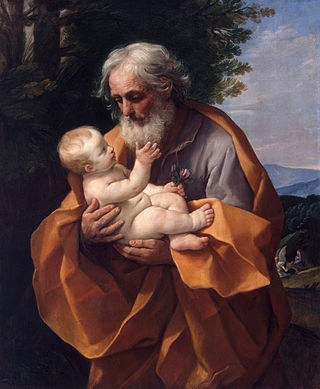
Saint Joseph's Day, also called the Feast of Saint Joseph or the Solemnity of Saint Joseph, is in Western Christianity the principal feast day of Saint Joseph, husband of the Virgin Mary and legal father of Jesus Christ, celebrated on 19 March. It has the rank of a solemnity in the Catholic Church. It is a feast or commemoration in the provinces of the Anglican Communion, and a feast or festival in the Lutheran Church. Saint Joseph's Day is the Patronal Feast day for Poland as well as for Canada, persons named Joseph, Josephine, etc., for religious institutes, schools and parishes bearing his name, and for carpenters. It is also Father's Day in some Catholic countries, mainly Spain, Portugal, and Italy. It is not a holy day of obligation for Catholics in the United States.
Saint Anthony, Antony, or Antonius, most often refers to Anthony of Padua, otherwise known as Saint Anthony of Lisbon, who is the patron saint of lost things in Christianity. This name may also refer to:

Blaise of Sebaste was a physician and bishop of Sebastea in historical Armenia who is venerated as a Christian saint and martyr.

Onuphrius lived as a hermit in the desert of Upper Egypt in the 4th or 5th centuries. He is venerated as Saint Onuphrius in both the Roman Catholic and Eastern Catholic churches, as Venerable Onuphrius in Eastern Orthodoxy, and as Saint Nofer the Anchorite in Oriental Orthodoxy.

Saint Nicholas Day, also called the Feast of Saint Nicholas, observed on 5 December or on 6 December in Western Christian countries, and on 19 December in Eastern Christian countries using the old church Calendar, is the feast day of Saint Nicholas of Myra; it falls within the season of Advent. It is celebrated as a Christian festival with particular regard to Saint Nicholas' reputation as a bringer of gifts, as well as through the attendance of church services.

Vincent of Saragossa, the Protomartyr of Spain, was a deacon of the Church of Saragossa. He is the patron saint of Lisbon and Valencia. His feast day is 22 January in the Catholic Church and Anglican Communion and the Orthodox Church, with an additional commemoration on 11 November in the Orthodox Church. He was born at Huesca and martyred under the Emperor Diocletian around the year 304.

Hilarion the Great (291–371) was an anchorite who spent most of his life in the desert according to the example of Anthony the Great (c. 251–356). While St Anthony is considered to have established Christian monasticism in the Egyptian desert, St Hilarion is considered by some to be the founder of Palestinian monasticism and venerated as a saint by the Orthodox and the Roman Catholic Church.
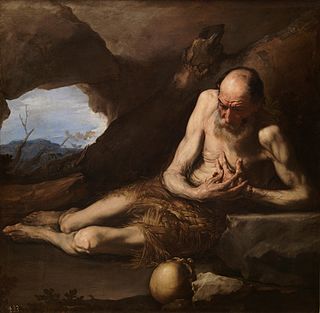
Paul of Thebes, commonly known as Paul the First Hermit or Paul the Anchorite, was an Egyptian saint regarded as the first Christian hermit, who was claimed to have lived alone in the desert of Thebes, Roman Egypt from the age of sixteen to the age of one hundred and thirteen years old. He was canonized in 491 by Pope Gelasius I, and is venerated as a saint by the Catholic Church, Eastern Orthodox Church, and Oriental Orthodox Churches.

Isidore the Labourer, also known as Isidore the Farmer, was a Spanish farmworker known for his piety toward the poor and animals. He is the Catholic patron saint of farmers, and of Madrid, El Gobernador, Jalisco and of La Ceiba, Honduras. His feast day is celebrated on 15 May.
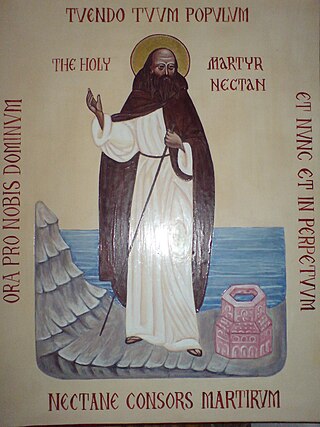
Saint Nectan, sometimes styled Saint Nectan of Hartland, was a 5th-century holy man who lived in Stoke, Hartland, in the nowadays English, and at the time brythonic-speaking county of Devon, where the prominent St Nectan's Church, Hartland is dedicated to him.

Joachim was, according to Christian tradition, the husband of Saint Anne and the father of Mary, the mother of Jesus. The story of Joachim and Anne first appears in the Biblical apocryphal Gospel of James. His feast day is 26 July, a date shared with Saint Anne.

Gerasimus of the Jordan was a Christian saint, monk and abbot of the 5th century AD.
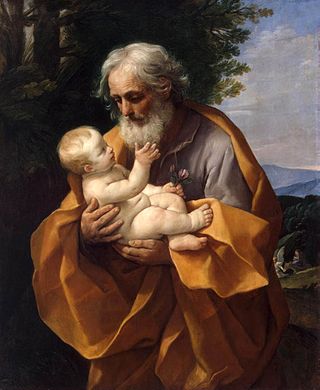
Joseph was a 1st-century Jewish man of Nazareth who, according to the canonical Gospels, was married to Mary, the mother of Jesus, and was the legal father of Jesus.
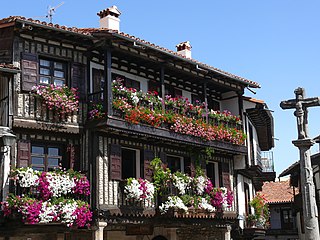
La Alberca is a municipality in the province of Salamanca in the autonomous community of Castilla y León, Spain. It is the capital of Sierra de Francia Comarca.
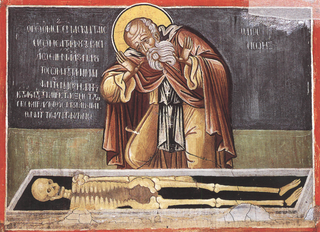
Saint Sisoës the Great was an early Christian desert father, a solitary monk pursuing asceticism in the Egyptian desert in a cave of his predecessor, St Anthony the Great. St Sisoës is revered as a saint by Roman Catholic and Eastern Orthodox churches, who consider him a wonderworker. His feast day is observed on July 19 [O.S. July 6].

Blessing of animals can be either of the animal or of the human-animal relationship, and can apply to pets and other companion animals, or to agricultural animals and working and other animals which humans depend on or interact with.
The patronal feast of Saint Francis and Saint Catherine is a religious and civil celebration annually held on 4 October in Italy and other locations influenced by Christianity.
















